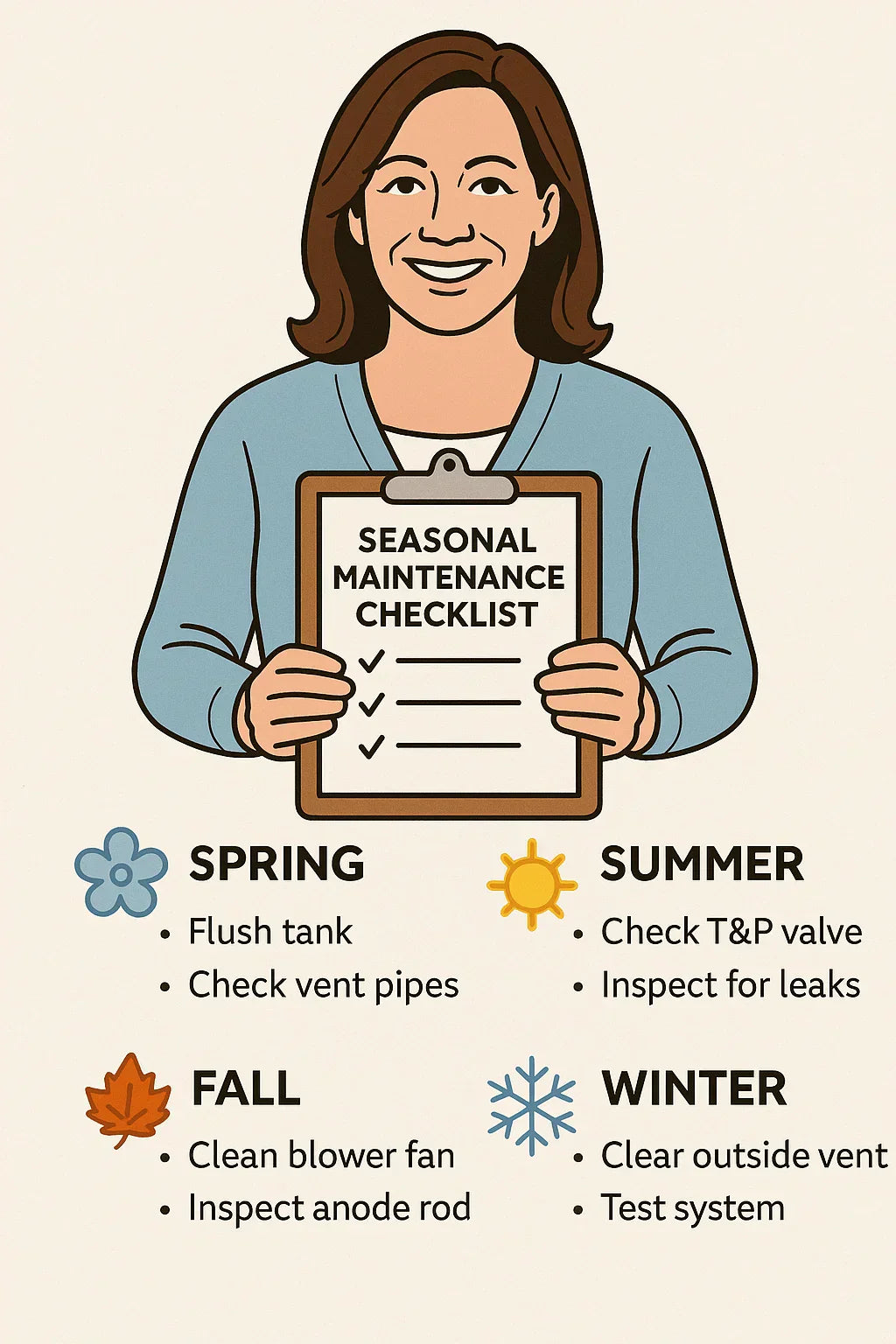👋 Samantha’s Motivation: Protecting Her Investment
When Samantha installed her State ProLine XE 50-Gallon Power Vent Gas Water Heater, she knew she had spent more than she would have on a standard vent model. That extra cost made her determined to get the longest possible lifespan out of it.
A neighbor once told her, “Our last water heater only lasted 6 years because we never maintained it.” That was all the warning Samantha needed. She created a seasonal checklist to make sure her unit runs efficiently, safely, and lasts 10–12 years (or longer).
This is her complete maintenance guide, packed with practical steps, timelines, and efficiency tips you can follow too.
🧹 Why Maintenance Matters for Power Vent Water Heaters
Samantha quickly learned that power vent water heaters require just a bit more upkeep than standard vent models because of their blower systems and PVC venting.
Here’s why regular maintenance matters:
-
Prevents sediment buildup → keeps heating efficient and prevents tank failure.
-
Extends lifespan → $30 in parts can save $1,000 in premature replacement.
-
Keeps warranty valid → many manufacturers require proof of proper care.
-
Avoids emergencies → fewer cold showers, fewer weekend repair bills.
-
Improves safety → ensures venting system is clear of blockages and backdraft risks.
📖 Family Handyman – Water Heater Maintenance
💧 Flushing the Tank: The #1 Task for Longevity
Sediment from your water supply gradually collects at the bottom of your tank. Over time, it causes:
-
Overheating (forcing the burner to work harder).
-
Noisy popping sounds.
-
Reduced capacity (less usable hot water).
-
Shortened tank life.
🔧 How to Flush Your Tank (Once Per Year)
-
Turn off gas supply and cold water inlet.
-
Attach a garden hose to the drain valve.
-
Open a hot water tap to let air in.
-
Drain water into a floor drain or bucket.
-
Refill tank and restart system.
Samantha schedules this every spring cleaning season.
📖 Energy.gov – Water Heating Tips
🛡️ Inspecting & Replacing the Anode Rod
The anode rod is a metal rod inside your tank that protects it from rust by corroding first. Think of it as a sacrificial bodyguard.
🔧 How Often to Check It
-
Every 2–3 years (more often if you have hard water).
🔧 Replacement Signs
-
Less than ½ inch thick.
-
Coated in calcium.
-
More than 6 inches of exposed steel wire.
Cost: $30–$60 for a replacement rod.
Samantha learned this simple swap can add 3–5 years to the life of her tank.
💨 Vent System Care: Keeping Air Flowing
Since power vent water heaters rely on PVC pipes and a blower fan, venting issues are a common failure point.
🔧 What Samantha Checks Every 6 Months
-
PVC vent pipes for cracks or loose joints.
-
Blower intake screen for dust/debris.
-
Outside termination cap to ensure it’s clear of snow, leaves, or nests.
She once found a bird nest inside her vent termination—a potentially dangerous blockage. Now, she makes it part of her fall routine.
🔌 Blower Fan & Electrical System
Unlike standard vent models, a power vent heater has moving parts. The blower motor is essential, but it can fail if not cared for.
🔧 Samantha’s Blower Maintenance Tips
-
Listen for new noises (grinding or excessive humming).
-
Clean intake screens to prevent dust buildup.
-
Check the power cord and outlet for moisture or wear.
-
Reset the system if error codes appear.
📖 This Old House – Water Heater Vent Types
🌡️ Thermostat & Temperature Settings
The U.S. Department of Energy recommends setting water heaters to 120°F.
Benefits of 120°F:
-
Safe for children (reduces scald risk).
-
Saves 4–22% annually on water heating costs.
-
Reduces mineral buildup inside the tank.
Samantha adjusted her thermostat down from 140°F and noticed her gas bill dropped about $10 per month.
📖 Consumer Product Safety Commission – Water Temperature Safety
🧰 Seasonal Maintenance Checklist
To stay on top of things, Samantha created a seasonal schedule:
🌸 Spring
-
Flush tank.
-
Inspect vent pipes.
☀️ Summer
-
Test T&P (temperature & pressure) relief valve.
-
Check for leaks around fittings.
🍂 Fall
-
Clean blower fan intake.
-
Inspect anode rod if it’s due.
❄️ Winter
-
Ensure outside vent termination is clear of snow/ice.
-
Run a test cycle before holidays (heavy guest usage).
📖 This Old House – Seasonal Water Heater Tips
⚠️ Common Mistakes Homeowners Make
-
Skipping flushes → sediment destroys burners and tank.
-
Forgetting blower care → dust clogs intake, reducing efficiency.
-
Thermostat set too high → wastes energy + increases scald risk.
-
Blocking vent exhaust → creates dangerous carbon monoxide risks.
-
Ignoring small leaks → often signal bigger issues ahead.
🏠 Samantha’s Real-World Experience
After 8 years with her power vent water heater, Samantha has had:
-
Zero major breakdowns.
-
Consistent hot water, even during peak family demand.
-
$50–$60 annual energy savings compared to her old unit.
She credits this success to her seasonal checklist and quick response whenever she notices changes (like noise from the blower fan).
👉 Her takeaway: “It only takes 30 minutes a few times a year, but it saves hundreds in repairs and years of extra life.”
✅ Conclusion: Keeping Your Heater Running Like New
If you want your power vent water heater to last as long as Samantha’s (or longer), here’s the bottom line:
-
Flush annually to prevent sediment.
-
Inspect anode rod every 2–3 years.
-
Keep blower fan and vent pipes clean.
-
Maintain safe thermostat settings.
-
Follow a seasonal routine.
👉 With these steps, you can enjoy 10–12 years of reliable hot water and lower long-term costs.
In the next topic we will know more about: Troubleshooting Guide: What to Do If Your Power Vent Gas Water Heater Isn’t Working







